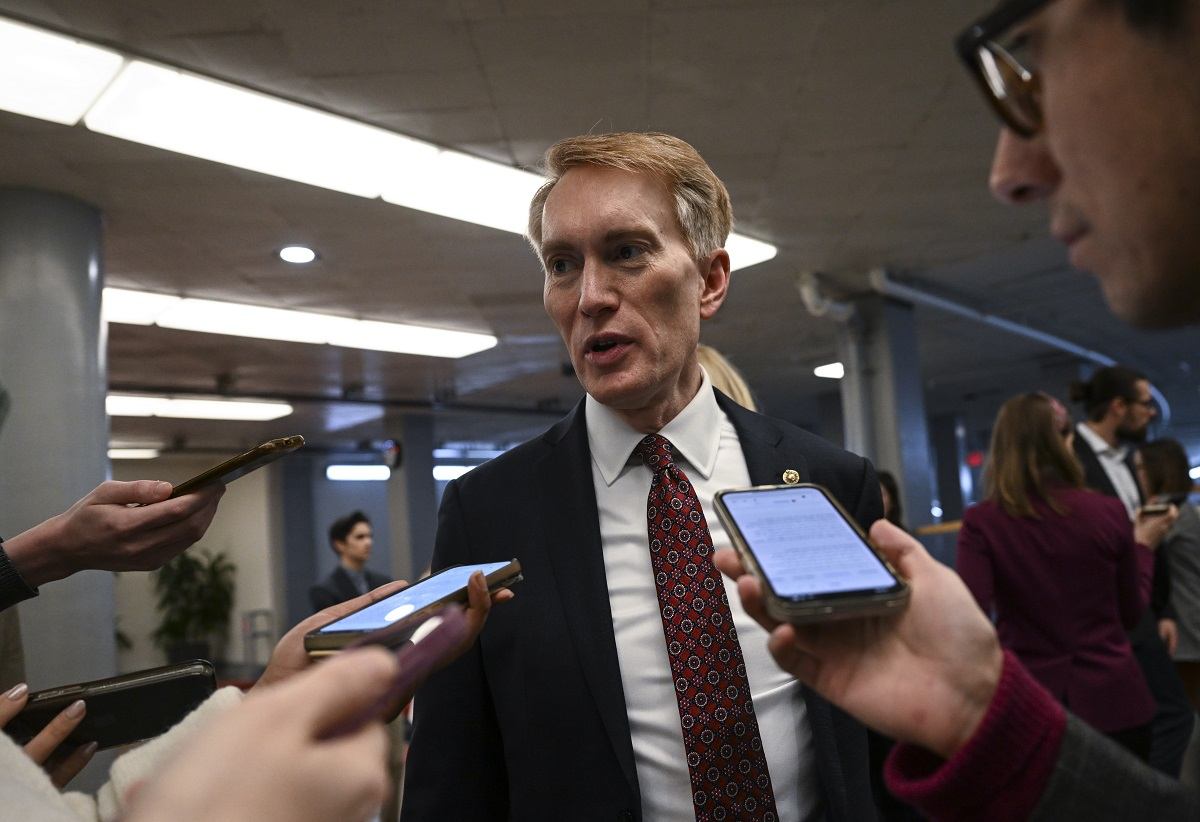
Sen. James Lankford (R-Okla.) talks to reporters at the Capitol in early February.
13:21 JST, March 18, 2024
The U.S. officers who screen migrants at the border to determine eligibility for asylum have been plowing through cases at a record clip since May, when the Biden administration placed tougher restrictions on people who cross illegally.
The officers are completing twice as many interviews per month as they did a year ago, and under the tighter rules, the percentage of migrants who are rejected and referred for deportation has more than doubled, according to the latest Department of Homeland Security data.
But the number of people screened remains a small fraction of the number who cross the border illegally. And the government does not have the detention capacity to hold others long enough to interview them.
As a result, the government has limited ability to reduce border crossings by adjusting the U.S. asylum system, whose delays and dysfunction are widely recognized as a driver of illegal immigration.
The bipartisan Senate border bill that failed last month would have greatly increased deportation capacity, providing $6 billion for immigration detention and deportations and funds to hire up to 4,300 asylum officers, a fourfold staffing increase. Republican opposition – led by former president Donald Trump, who is campaigning against President Biden in the 2024 election – sank the bill, which Homeland Security Secretary Alejandro Mayorkas said would have delivered “the most dramatic change to our system in decades.”
“We are doing what we can at a time when we continue to be starved for resources,” Mayorkas said in an interview Friday.
“It’s about funding the system so that it is more efficient and effective,” he said, “rather than asking the government to work without giving it the resources to actually do the work.”
Biden officials are anticipating a seasonal increase in illegal entries this spring, and the administration is under significant pressure to avoid chaotic scenes of mass border crossings that would hurt the president’s reelection campaign.
With polls showing immigration among Biden’s worst-rated issues, administration officials have been weighing new executive actions to deter illegal crossings, including more restrictions on asylum access at the border.
But the latest DHS statistics show that changes to asylum policy would have little effect without a major increase in staffing to process migrants’ claims and expanded detention and deportation capacity for those who don’t qualify for protection.
DHS completed more than 115,000 “credible fear” interviews of migrants between last May and late February, the data shows, a bureaucratic feat made possible because the department has assigned nearly all of its 1,000 asylum officers to work on border cases. To boost output even more, staffers with previous asylum training have been reassigned to border cases to help screen migrants.
Despite the all-hands-on-deck approach, the number of interviews the officers completed was dwarfed by the nearly 1.7 million illegal crossings at the U.S.-Mexico border during that time period. “We are maxing out the system, and it hasn’t kept pace with the increase,” said one DHS official who spoke on the condition of anonymity to speak candidly.
While not every migrant who crosses illegally claims a fear of persecution – the first step in triggering an asylum officer interview – thousands of migrants are released into the United States every month because U.S. authorities lack the capacity to detain applicants long enough to screen out weak or baseless cases at the border.
Under U.S. immigration law, anyone who reaches U.S. soil has the right to seek asylum, regardless of how they arrive. Migrants who claim a fear of persecution in their home countries are referred to a U.S. asylum officer for an interview to determine whether their claims are credible. Applicants who face persecution on the basis of race, religion, gender, political opinion or membership in a particular social group are eligible for an asylum claim, and applicants can also be referred to the courts if officers determine the person is likely to face imminent harm if returned to their country.
For much of the past decade, as soaring numbers of migrants crossed illegally and expressed fear, most were able to pass the initial screening, which sent their cases to U.S. immigration courts. A much smaller number of those who made a fear claim – about 20 percent – were ultimately granted U.S. asylum. Many migrants never complete the application process after they are released from custody to await a court hearing, court data shows.
The gap between the relative ease of passing the initial screening and the tougher odds of getting U.S. asylum is considered by lawmakers from both parties to be an incentive for illegal border crossings. Migrants with weak or fake claims can avoid deportation and live and work in the United States while waiting for their asylum case to plod through clogged U.S. immigration courts – a process that takes five to seven years on average, according to the latest government estimates.
And because DHS doesn’t have enough asylum officers to screen all the migrants expressing fear, border crossers who don’t get initial interviews are referred to the immigration court system and released into the United States. About half of illegal border crossings are families with children, who are generally not detained.
The Biden administration put tougher asylum restrictions in place by implementing its “Circumvention of Lawful Pathways” rule after lifting the pandemic-era border controls known as Title 42 last May. The new rule penalizes asylum seekers if they cross the border illegally or fail to apply for protection in another nation they travel through en route to the U.S. border, creating what the government calls a “presumption of ineligibility.”
Immigrant advocate groups and many Democrats denounced the measures as similar to Trump’s efforts to shut off asylum access. Biden officials said the rule was key to cutting back the number of asylum claimants with weak cases who pass the first hurdle – part of the administration’s broader strategy to expand opportunities for migrants to enter legally while ramping up deportations for those who cross unlawfully.
Between 2014 and 2019, about 85 percent of migrants who claimed a fear of persecution passed the initial screening stage and were referred to U.S. immigration courts, according to DHS data. That number has dropped to 59 percent under Biden’s new measures, the latest statistics show.
DHS’s emphasis on asylum cases has diverted so much attention to the border that its other caseloads are growing worse. The backlog of “affirmative asylum” cases – from applicants who seek protection after entering the country legally – nearly doubled last year to more than 1.1 million cases.
“People are going to keep coming, and at least in the short term, it’s hard to see how the available resources can match the arrivals,” said Kathleen Bush-Joseph, an analyst at the nonpartisan Migration Policy Institute in Washington. “The Biden administration has made huge investments, but more needs to be done, and Congress is going to have to act to make that happen.”
Sen. James Lankford (R-Okla.), the lead sponsor of the failed border bill, said authorities need tighter rules and more resources to discourage migrants without valid asylum claims from making the journey to the U.S. border.
One of the provisions in the bill would have made staying in the United States more difficult for asylum applicants who could not prove it was unsafe to relocate within their home countries. Migrants who express fear of return often say they are fleeing threats by criminal groups in their neighborhoods.
Other potential asylum changes in the bill would have further limited applicants’ ability to appeal a rejection, and denied more claims by those who come to the U.S. border after resettling safely in another country.
“What really deters folks from coming is someone they know getting turned around,” Lankford said in an interview Thursday. “If there is a higher standard, and we have faster removals, then the incentive to pay a smuggler $10,000 goes away.”
“At a minimum, there is a pause so that people say: The rules have changed and I shouldn’t make that trip,” he said.
Lankford said he doubts the bipartisan bill will be revived. A new battle over the $60 billion DHS budget has left lawmakers considering a separate stopgap bill to keep the department funded through next year. The discussions don’t include an expansion of asylum-processing capacity, which officials say they need to apply the stricter standards and discourage weak or false fear claims.
“I don’t have any reason to have hope at this point,” Lankford said. “No one is pushing me to get something resolved. Democrats are saying the president can’t do anything without the bill. Republicans are saying he’s not doing what he can without it.”
Immigrant advocates remain angry with the administration over Biden’s asylum restrictions, with some referring to them as a “ban,” even though more than half of applicants are still clearing the initial hurdle under the tighter screening rules.
Christina Asencio, research director at Human Rights First, a New York-based advocacy organization for migrants, said Biden’s measures are unfair because asylum seekers who need protection may not be aware that they face penalties if they cross the border illegally.
“It increases the likelihood people will be returned to potential persecution,” Asencio said in an interview. “They are stuck with a choice of imminent risk of harm or a confusing, complex architecture they can’t grasp.”
Asencio said it isn’t realistic to ask asylum seekers to wait in Mexican border cities for months while requesting an appointment at a U.S. port of entry. “They’re afraid of being arrested and detained,” she said, or attacked by criminal groups.
In July, a U.S. district court in California found Biden’s asylum restrictions unlawful after the American Civil Liberties Union and other immigrant advocates sued, but that ruling was stayed by a federal appeals court. The litigation is on pause while the ACLU and others attempt to negotiate a settlement with the administration.
The union that represents asylum officers backed the ACLU lawsuit and urged the court to invalidate the administration’s restrictions, claiming that they violate U.S. law and the professional ethics of the workforce tasked with implementing the tighter rules.
Michael Knowles, a spokesman for the union, said the restrictions make the screening process “more complicated, more time-consuming and more inadequate” because asylum officers have more responsibility to make sure they’re not condemning applicants to grave risks.
Fear screenings for migrants in border custody aren’t meant to be full asylum hearings, Knowles said. He compared the role of the asylum officer to a first responder performing emergency triage “in a mass-casualty situation.”
“You screen into the hospital those who need further treatment or examination,” he said. “You don’t screen out people who may be badly hurt. That’s the whole point of the credible-fear interview: to ensure we’re not turning away bona fide refugees at risk of harm.”
"News Services" POPULAR ARTICLE
-

American Playwright Jeremy O. Harris Arrested in Japan on Alleged Drug Smuggling
-

Japan’s Nikkei Stock Average as JGB Yields, Yen Rise on Rate-Hike Bets
-

Japan’s Nikkei Stock Average Licks Wounds after Selloff Sparked by BOJ Hike Bets (UPDATE 1)
-

Japan’s Nikkei Stock Average Buoyed by Stable Yen; SoftBank’s Slide Caps Gains (UPDATE 1)
-

Japanese Bond Yields Zoom, Stocks Slide as Rate Hike Looms
JN ACCESS RANKING
-

Tokyo Economic Security Forum to Hold Inaugural Meeting Amid Tense Global Environment
-

Keidanren Chairman Yoshinobu Tsutsui Visits Kashiwazaki-Kariwa Nuclear Power Plant; Inspects New Emergency Safety System
-

Imports of Rare Earths from China Facing Delays, May Be Caused by Deterioration of Japan-China Relations
-

University of Tokyo Professor Discusses Japanese Economic Security in Interview Ahead of Forum
-

Japan Pulls out of Vietnam Nuclear Project, Complicating Hanoi’s Power Plans
























